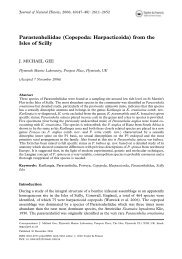An Updated Classification of the Recent Crustacea
An Updated Classification of the Recent Crustacea
An Updated Classification of the Recent Crustacea
You also want an ePaper? Increase the reach of your titles
YUMPU automatically turns print PDFs into web optimized ePapers that Google loves.
inoidea is difficult, because <strong>the</strong>y do not clearly enter<br />
in a major group. You write that, for Spears herself<br />
(p. 69), ‘‘molecular data seem to indicate a placement<br />
[<strong>of</strong> Cyclodorippoidea] somewhere between<br />
<strong>the</strong> raninids and <strong>the</strong> higher eubrachyurans.’’ So, <strong>the</strong><br />
molecular data exactly give <strong>the</strong> same results that<br />
<strong>the</strong> morphological and ontogenetic ones. The two<br />
groups Raninoidea and Cyclodorippoidea (<strong>the</strong> last<br />
name is used by convenience, but perhaps <strong>the</strong>y<br />
form three distinct families, see Tavares) seem<br />
apart, but where is <strong>the</strong> best way?<br />
Submitted by Danièle Guinot,<br />
Muséum National d’Histoire Naturelle, Paris<br />
DECAPODA: BRACHYURA<br />
Evidence from morphology and larval development<br />
points to <strong>the</strong> polyphyletic nature <strong>of</strong> <strong>the</strong> Trapeziidae.<br />
There are three separate groups: one comprises Trapezia,<br />
Quadrella, Hexagonalia, Calocarcinus, Philippicarcinus<br />
and Sphenomerides, a second Tetralia<br />
and Tetraloides, and a third Domecia, Jonesius,<br />
Palmyria and Maldivia.<br />
Submitted by Peter Castro,<br />
California State Polytechnic University, Pomona<br />
DECAPODA: BRACHYURA<br />
I disagree that all Brachyura with female gonopores<br />
on P3 coxa and with sperma<strong>the</strong>cae at <strong>the</strong> extremities<br />
<strong>of</strong> thoracic sutures 7/8 are separated in two<br />
different major sections, Dromiacea and Eubrachyura,<br />
with <strong>the</strong> Raninoidea and Cyclodorippoidea<br />
distributed in a basal group inside <strong>the</strong> Eubrachyura.<br />
In that case, how to make a definition <strong>of</strong> both<br />
Dromiacea and Eubrachyura as a whole? The Podotremata<br />
may receive all Brachyura with female<br />
gonopores on P3 coxa and with sperma<strong>the</strong>cae at<br />
<strong>the</strong> extremities <strong>of</strong> thoracic sutures 7/8, i.e., two different<br />
apertures. The Eubrachyura may receive all<br />
Brachyura with a sternal location <strong>of</strong> female gonopores<br />
(vulvae on <strong>the</strong> thoracic sternum, sternite 6);<br />
<strong>the</strong>re is now a sole female orifice for reproduction<br />
(egg laying, intromission <strong>of</strong> male pleopod, and storage<br />
<strong>of</strong> <strong>the</strong> spermatozoas). <strong>An</strong>o<strong>the</strong>r synapomorphy<br />
(among o<strong>the</strong>rs) <strong>of</strong> <strong>the</strong> assemblage Heterotremata-<br />
Thoracotremata is <strong>the</strong> morphology <strong>of</strong> <strong>the</strong> first male<br />
pleopod, which is completely closed and provided<br />
with two distinct basal foramina (instead <strong>of</strong> only<br />
one in <strong>the</strong> Podotremata). To concile <strong>the</strong> evident<br />
apart position <strong>of</strong> <strong>the</strong> Raninoidea and Cyclodorippoidea<br />
(but, perhaps consider three distinct families:<br />
Cyclodorippidae, Cymonomidae, Phyllotymolinidae),<br />
I suggest to range <strong>the</strong>m among <strong>the</strong> Podotremata<br />
in Archaeobrachyura Guinot, 1977 emend.<br />
(i.e. with <strong>the</strong> exclusion <strong>of</strong> <strong>the</strong> Homoloidea).<br />
Submitted by Danièle Guinot,<br />
Muséum National d’Histoire Naturelle, Paris<br />
DECAPODA: BRACHYURA: DROMIACEA<br />
I disagree that <strong>the</strong> section Dromiacea contains <strong>the</strong><br />
Homoloidea. The Dromiacea and Homoloidea are<br />
two different lineages. I suggest to consider a Section<br />
Podotremata, with three subsections: Subsection<br />
Dromiacea, containing two superfamilies<br />
Homolodromioidea (Homolodromiidae) and<br />
Dromioidea (Dromiidae, Dynomenidae); Subsection<br />
Homoloidea (Homolidae, Latreilliidae, Poupiniidae);<br />
Subsection Archaeobrachyura (Cyclodorippidae,<br />
Cymonomidae, Phyllotymolinidae, and<br />
Raninidae). The monophyly <strong>of</strong> <strong>the</strong> Dromiacea is<br />
well supported by many features; <strong>the</strong> same for<br />
Homoloidea. I recognize that <strong>the</strong> monophyly <strong>of</strong> <strong>the</strong><br />
Archaeobrachyura emend. (without <strong>the</strong> Homoloidea)<br />
is not so well supported and that <strong>the</strong>se crabs<br />
show puzzling features, but <strong>the</strong>y are all very specialized<br />
and modified by <strong>the</strong> burrowing life. Their<br />
attribution to <strong>the</strong> Podotremata is, at least for <strong>the</strong><br />
moment, supported by <strong>the</strong> appendicular location <strong>of</strong><br />
female gonopores (on P3 coxa) and <strong>the</strong> sperma<strong>the</strong>cae<br />
at <strong>the</strong> extremities <strong>of</strong> thoracic sutures 7/8, <strong>the</strong><br />
features <strong>of</strong> <strong>the</strong> sternal plate, <strong>the</strong> arthrodial cavities<br />
<strong>of</strong> <strong>the</strong> pereiopods, and o<strong>the</strong>rs characters. If we include<br />
<strong>the</strong> Cyclodorippidae, Cymonomidae, Phyllotymolinidae,<br />
and <strong>the</strong> Raninidae in <strong>the</strong> Eubrachyura,<br />
which becomes <strong>the</strong> diagnosis <strong>of</strong> <strong>the</strong> Eubrachyura?<br />
Submitted by Danièle Guinot,<br />
Muséum National d’Histoire Naturelle, Paris<br />
DECAPODA: BRACHYURA:<br />
HETEROTREMATA, THORACOTREMATA<br />
It is important to recall <strong>the</strong> original definition <strong>of</strong><br />
<strong>the</strong> taxa given by Guinot (1977, 1978).<br />
The section Hererotremata contains <strong>the</strong> Brachyuran<br />
families, ALL THE MEMBERS <strong>of</strong> which<br />
are sternitreme for <strong>the</strong> female gonopores, and<br />
ONLY some members, at least, are podotreme<br />
for <strong>the</strong> male gonopores.<br />
The section Thoracotremata contains <strong>the</strong> Brachyuran<br />
families, all <strong>the</strong> members <strong>of</strong> which are sternitreme<br />
for <strong>the</strong> female and male gonopores. It<br />
means that, for <strong>the</strong> Heterotremata, in <strong>the</strong> Leucosiidae<br />
or Leucosioidea by example it exists members<br />
with male gonopores on <strong>the</strong> P5 coxa and o<strong>the</strong>r<br />
members with sternal male apertures. But, in <strong>the</strong><br />
last case, it is only a coxo-sternal location <strong>of</strong> <strong>the</strong><br />
penis. The same is true for <strong>the</strong> Dorippidae, where<br />
some members show a coxo-sternal location <strong>of</strong> <strong>the</strong><br />
penis.<br />
Submitted by Danièle Guinot,<br />
Muséum National d’Histoire Naturelle, Paris<br />
Contributions in Science, Number 39 Appendix I: Comments and Opinions 113











